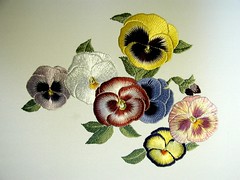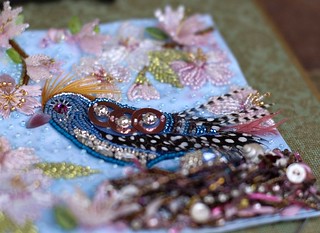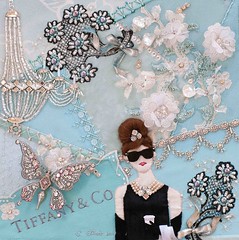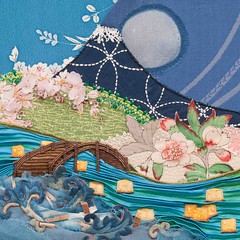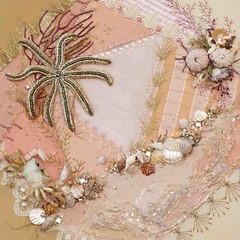I've been on a bit of a tangent lately, researching the background for a few embroideries that I viewed at the Lessons Learned: American Schoolgirl Embroideries exhibit currently showing at the Baltimore Museum of Art through May.
Of the twenty embroideries on exhibit, many of them were silk and chenille with classical, biblical or literary themes, a common approach in schools at the time.
Last post, I went into some detail on the Queen of Sheba embroidery. Today, I'd like to share another embroidery which drew my attention...
 |
| Caroline, the Heroine of Lichtfield, 1817 silk ground, silk embroidery threads, silk chenille, paint, cotton lining Unites States, possibly Maryland, Easton |
The embroidery depicts the heroine of an eighteenth century best-selling novel, Caroline of Lichtfield or Memoirs of a Prussian Family, originally published in French (1786) by author Isabelle de Montolieu, later translated into English by William Holcroft and published in Britain, and eventually released in the United States in 1798.
The story pre-dates Jane Austen, yet deals with a familiar plot line of a young heiress eventually deciding to marry a man she had previously thwarted due to facial deformity, recognizing his virtue as his most attractive and marriageable feature.
The embroidery is framed by a wonderfully painted mat with cornucopias full of flowers...
And fruit...
And butterflies flitting about...
It is dated and signed at the bottom, "Julia Ann Thomas's work" with the date 1817...
With the name Easton also included. Easton happens to be a small town on the Eastern shore of Maryland where a woman named Julia Ann Thomas was known to have taught at the Easton Female Academy.
Elements of the design and stitching however are characteristic of the styles from the Moravian schools in Pennsylvania and North Carolina but no record of a Julia Ann Thomas has been found.
As I studied the pictures I had taken, I began to wonder about the main character of the embroidery, Caroline of Lichtfield (not Litchfield in England, but Licthfield, a fictitious Prussian estate); sitting at the edge of a lake, book set aside and lost in thought...
With mountains painted in the background...
And an anthropomorphic representation of her dog by her side...
It was this adorable rendering of Caroline's faithful companion that led me to start researching the story to find if this little guy had a name and why a young woman in 1817 would find the story worthy of memorializing in embroidery. The text is available but quite expensive. Luckily, I found this hardcover version on Amazon with a great deal of the novel available for preview.
I had to stop reading in order to write this so I still have not found any more information about the dog but I have learned that Mary Wollstonecraft read and admired the book calling it the 'prettiest thing she had ever read' and Jane Austen also read it and called it 'beautiful'.
From what I have read so far, it is a novel with a young and naive heroine, raised on a country estate, far from the sophistication of court and ready to marry a Prince Charming. The "prince" suitor proposed by her father is hardly dashing and young but rather an older man with a facial deformity and an Ambassador to Petersburg...
What ensues is melodrama surrounding two suitors, one young, handsome and ardent; the other is older, wiser and of tested virtue. You get the gist. Thanks to Jane Austen, we know the type of story quite well even though Ms. Austen published some twenty years or so after this novel was written.
From what I can tell, it was the chick lit of the day and it was widely read and very popular. The embroidery itself is as charming as the novel and I am grateful to Ms. Thomas for introducing me to Caroline.
Another embroidery that caught my eye was also inspired by popular literature of the day, in this case, James Thomson's epic poem, The Seasons (1730). James Thomson was Scottish and one of the leading poets in 18th century literature; primarily known for The Seasons, a four-part poetic work about nature and its cyclical transformations.
The work was very popular and inspired mezzotints like the one by Laurie and Whittle (1794) entitled Spring...
It was the illustration above that provided the inspiration for the embroidery titled Spring below, embroidered by Maria Antoinette Dorsey, possibly in the Moravian Seminary for girls at Lititz or Bethlehem.
 |
| Spring, 1825-1830. Stitched by Maria Antoinette Dorsey silk ground, silk embroidery threads, watercolor, linen lining United States, possibly Pennsylvania |
Glare from overhead lights made pictures of this work nearly impossible. In comparing the illustration with the embroidery, did you notice that the man was excluded from the needled version?
Now why do you think that was?
Speaking of women, did you happen to read this article in the Wall Street Journal reviewing Women After All by Melvin Connor, a professor of Anthropology at Emory University? It was a triumph for women, IMHO, largely due to the fact that both the review and the book were written by men. Check it out. It's worth your time.
Happy Monday. Happy Spring.



























































